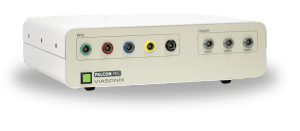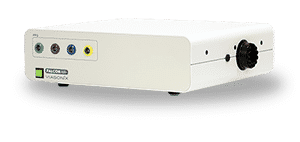What is Brain Death Assessment?
Brain Death, or Cerebral Circulatory Arrest, is the irreversible complete loss of brain function. This condition of brain damage is characterized by almost no volume blood flow to the brain and very high distal resistance to arterial flow.

How to use TCD for Brain Death
Transcranial Doppler (TCD) can help detect the different progression stages of cerebral circulatory arrest towards complete brain death. Distal resistance to flow increases sharply and TCD can serve as an ancillary modality for the detection and confirmation of brain death in addition to other modalities for brain death determination. Timely identification of brain death is particularly important in cases where an organ donation is an option.
The special guidelines for the diagnostic criteria of brain death must be followed very carefully. Insonation must be bilateral and include all possible windows that access the anterior and posterior circulations through the temporal and suboccipital windows. All cerebral vessels must be insonated and appropriately analyzed. One of the most important rules is that in order to accept the absence of a Doppler signal in any blood vessel, a prior valid measurement must be identified in the same vessel to ensure that the temporal window access is acceptable.

2 MHz Doppler Probe
High quality and ultra sensitive Doppler probe
Using the Dolphin for Brain Death Detection
The Dolphin provides high Doppler sensitivity to ensure that the intracranial Doppler measurements do not miss cerebral flow. The phasic or power m-mode display functions help to identify the location (depth) of a possible blood flow along the ultrasound beam.
The special capabilities of the Dolphin TCD system support the post-processing review options in the time domain as well as in the depth domain. Since it is critical to ensure that no valid blood flow signal is missed, this unique Dolphin processing ability supports scrolling back to earlier sections of the measurement. The Dolphin allows changing the depth and closely reviewing the signal at all possible depths at each such time location.
The Dolphin Doppler processing allows increasing the sample volume significantly to as much as 20 mm and decreasing the filter to just 10 Hz in order to validate that no spectral signal is missed. Unlimited waveforms or signals can be captured and documented for each blood vessel for further proof of diagnosis.
Expected Results
A suspected cerebral circulatory arrest appears in various forms in the Doppler spectrum as the condition progresses. Measurements must be performed for both the anterior and posterior circulations. The various stages may include:
- Absence or reverse of end-diastolic flow;
- Reverberating flow which appears as positive and negative retrograde blood flow such that the mean positive flow is around zero;
- Small and short systolic spikes;
- No signal at all (only under the condition that a valid measurement was previously made at the same site).
Selected Literature
Assessment: transcranial Doppler ultrasonography: report of the Therapeutics and Technology Assessment Subcommittee of the American Academy of Neurology. Sloan MA et al., Therapeutics and Technology Assessment Subcommittee of the American Academy of Neurology. Neurology. 2004 May 11;62(9):1468-81
Transcranial Doppler Series Part IV: Case Studies, Heather A Nicoletto and Marilyn H. Burkman, Am J Electroneurodiagnostic Technol, 49:342-360, 2009
Transcranial Doppler ultrasonography to confirm brain death: a meta-analysis, Louisa M. Monteiro et al., Intensive Care Med (2006) 32:1937–1944
Transcranial Doppler: Techniques and advanced applications: Part 2, Sharma AK, Bathala L, Batra A, Mehndiratta MM, Sharma VK, Ann Indian Acad Neurol. 2016 Jan-Mar;19(1):102-7
Ultrasound Assessment of the Intracranial Arteries, Nabavi, Ritter, Otis, and Ringelstein, Introduction to Vascular Ultrasonography, By John Pellerito, MD and Joseph F Polak, 2012
Cerebral Circulatory Arrest, Sergio Calleja, In Cerebrovascular Ultrasound in Stroke Prevention and Treatment, Edited by Andrei V. Alexandrov, 2011 Blackwell Publishing Ltd.
Neuro-ultrasonography, Ryan Hakimi, Andrei V. Alexandrov, and Zsolt Garami, Neurol Clin 38 (2020) 215–229
Transcranial Doppler, Peter J. Kirkpatrick and Kwan-Hon Chan, Chapter 13, in Head Injury. Edited by Peter Reilly and Ross Bullock. Published in 1997 by Chapman & Hall, London
Disclaimer of Information & Content
The content of Viasonix Ltd. website is for information only, not advice or guarantee of outcome. Information is gathered and shared from reputable sources; however, Viasonix Ltd. Management is not responsible for errors or omissions in reporting or explanation. No individuals, including those under our active care, should use the information, resources or tools contained within this self-diagnosis or self-treat any health-related condition. Viasonix Ltd. Management gives no assurance or warranty regarding the accuracy, timeliness or applicability or the content.







